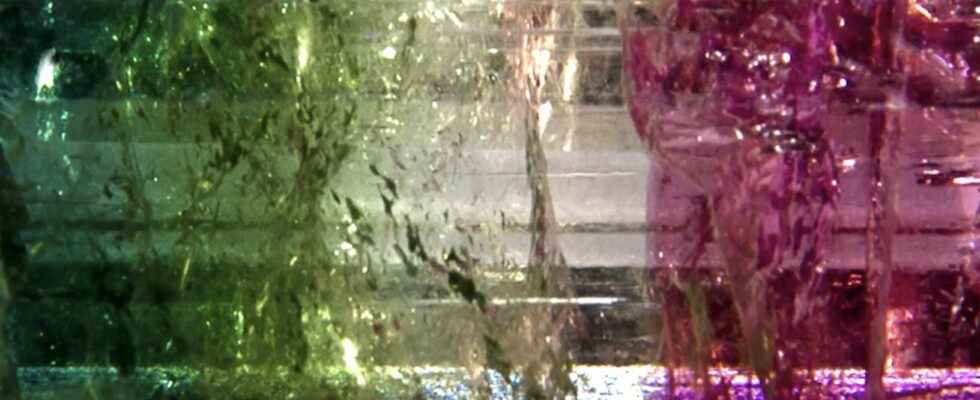Silicates are an important family of minerals which represent nearly 95% of the constituents of Earth’s crust. This family includes about 600 species different minerals, whose atomic architecture is characterized by the basic structural motif (SiO4)4-a anions (ion negative) assembled in the form of a tetrahedron.
A silicate is therefore a salt composed of dioxide of silicon (SiO2) associated with various metal oxides: aluminum, magnesium, iron, calcium, potassium, sodium… These oxides are cations (positive ions), which ensure the electrical neutrality of the mineral. The atomic skeleton of silicates is therefore formed by the organization of tetrahedrons (SiO4)4-which are linked by atoms oxygen located at the summits. This arrangement allows the creation of structures of small dimensions, composed of a few tetrahedral groups, or of structures polymers much larger in size. In this case, the tetrahedrons are organized in linear chains, in ribbons, in sheets, or in complex three-dimensional forms. In these sequences, it happens that the silica is replaced by an aluminum atom. We then speak of aluminosilicate.
This structural variability and the association with various cations allows the creation of a very large number of silicate minerals. These different mineral species are generally classified according to their composition and the sequence of tetrahedrons.
The main mineral species
The nesosilicates can be considered the simplest form of silicate minerals. They are so-called free tetrahedral silicates, in the sense that the tetrahedrons (SiO4)4- are joined by two divalent cations: Mg (magnesium) or Fe (iron), or by a tetravalent cation Zr (zirconium). Peridots (olivine), zircongarnets, topaz, sphene but also andalusite, kyanitesillimanite or staurolite are nesosilicates.
The formula of zircon for example is therefore: SiO4Zr. Andalusite, sillimanite and kyanite all have the same chemical formula: Al2SiO5. They are part of a subcategory called silicatealumina. In fact, these three minerals are differentiated not by their chemical composition, but by the arrangement of the tetrahedrons and the structure of their crystal lattice.
Garnet as for him accepts a certain variability in its composition. Of formula R32+X23+Whether3O12the R site can thus be occupied by an atom of Ca, Mg, Fe2+ or of Mn. The X site can be occupied by an atom of Al, Fe3+Ti or Cr.
The sorosilicates are defined by groups of two tetrahedra joined by a common oxygen. The basic formula therefore becomes (If2O7)6-. It is a fairly rare mineral species that includes the magnificent epidotes.
As their name suggests, cyclosilicates are defined by a cyclic structure, the tetrahedrons forming a closed chain. The base radical is therefore (SiO3)2- and the final chemical formula of the mineral will depend on the number of tetrahedrons in the ring. The best known cyclosilicates are tourmalines and beryls, which include emeralds or aquamarine.
The inosilicates are formed by chains of tetrahedrons centered on the silica atom. They comprise two large mineral families: pyroxenes, formed by simple chains of formula (SiO3)2-and amphiboles, double chains of formula (Si4O11)6-.
Large family of silicate minerals, the phyllosilicates are characterized by their organization in layers of tetrahedrons. These are united by three of their vertices, thus forming a planar network. Stacking these layers will give minerals in sheets or fibrous such as micas, talc or even clay minerals. This specific arrangement generates planes of fragility (we speak of planes of cleavage) that it is easy to detach from each other.
Clay minerals have the particularity of being composed of stacks of tetrahedral and octahedral layers. The space between the sheets can contain water and various ions. When the’clay becomes hydrated, this increases the distance between the layers: the clay “swells”. On the contrary, when it dries up, the space between the sheets will contract. These variations of volume during the’hydration and some dehydration are characteristic of clay minerals.
In the case of tectosilicates, the tetrahedrons are united to each other by their four vertices, there is no free site. The formula is thus SiO2or if4O8. Among the tectosilicates are the feldspars and feldspathoids. Quartz, another tectosilicate, has the same architecture. Feldspars are characterized by the substitution of an Si ion4+ by an Al ion3+ in the tetrahedra, the remaining positive charge being compensated by the insertion of a cation such as K, Na or Ca. These variations define the different types of feldspar: potassium, sodium or calcium.
You will also be interested
Interested in what you just read?
